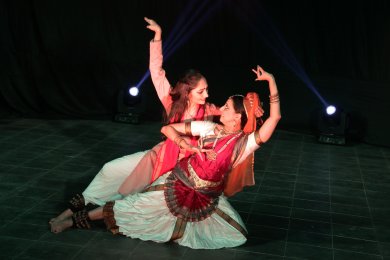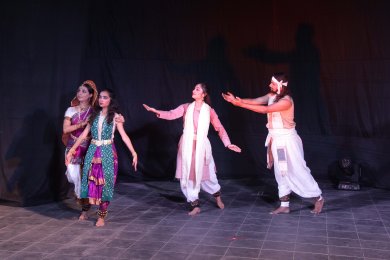
|   |

|   |
‘Siddharth’ attempts a parallel to the Buddha - S.D. Desai e-mail: sureshmrudula@gmail.com November 16, 2015 In visual arts, in a fresh virgin ambience at times creativity and expression vigorously spring up and in the case of budding performers they become especially noticeable. Two of Nrityabharati founder director Elakshi Thakore’s sons are associated with two allied arts - one, architect Kabir, with drama, the other, dancer Chandan, with dance choreography. In the format of drama, Kabir’s strength is in combining the art with socially oriented ideas. Chandan, particularly of late, is known to develop an interesting interplay of story and imaginative choreography. Even as they redesigned and renovated their spacious house and dance class, they saw scrap collecting in the backyard and soon thought of and built a Scrap Theatre with tiled flooring on it, a small space open to the sky, and an improvised flight of a couple of steps for at the most fifty spectators to sit on in front rubbing shoulders. One day two short one-acts were staged, the next (November 1) three dance presentations were made, informally. The viewers in close proximity, among them a poet or two, dancers, actors, musicians, an eminent tax consultant, had an anubhooti they never had had earlier. Of the three short dance pieces Chandan Thakore presented, including ‘The Beauty of Nature’ on Western piano music and ‘The Other Rhythm’ on Taufiq Qureshi’s composition, the third ‘Siddharth’ particularly caught the imagination of the viewers with choreography, individual expression and lighting designs. This ‘Siddharth’ gave glimpses of German Nobel Laureate Hermann Hesse’s famous novelette set in India and written in a lyrical style portraying his Brahmin protagonist, who feels his ‘vessel was not full’ though all the traditional knowledge was given to him and leaves home to be a Samana, an ascetic 

Siddharth is not satisfied with what the Buddha offers either. Salvation cannot be taught, he realizes. It should be self-knowledge through suffering. With the conviction that there is beauty in everything, he turns sensuous, gets intimate with a Ganika and has a son. But he finds no happiness and experiences despair. He awakens refreshed from a slumber of despair, however, listens to the voice from within and voices from the river. Finding a parallel in his son’s independent thinking with his own that had him leave home, he realizes the value of empathy and love for everyone. There is a moment of self-realization, of truth, which according to him, cannot be communicated with words - as the Buddha, in his perception, tried to do. The Nrityabharati group, we are told, was privileged to have performed excerpts from ‘Siddharth’ a couple of years ago in an auditorium right in front of the novelist’s residence. Here at the Scrap Theatre, lights gave an aura of ethereal beauty particularly to the Siddharth-Ganika scenes. Nirali and Twisha Thakore portrayed the scenes and the integral sentiments with such precocious understanding and involvement, oblivious as it were of spectators’ presence, that in their a-physical quality they reminded one of Jayadeva’s lyrical rendering of Radha-Krishna shringar - the undercurrent of its rich spiritual connotations rubbing off its explicit earthy grossness. The group now plans to turn the whole novel into a full-fledged dance drama. That will be a daunting task for both Paresh Vyas, who translated some parts of the work, probably from its English translation, and Chandan Thakore, who will direct and choreograph it. For, Siddharth is a complex character and he represents a profound philosophy highlighted with symbols overflowing with meaning. The dancers seem to be, like young Siddharth, empty vessels keen to be filled and full. Dr. S.D. Desai, a professor of English, has been a Performing Arts Critic for many years. Among the dance journals he has contributed to are Narthaki, Sruti, Nartanam and Attendance. He guest-edited Attendance 2013 Special Issue. His books have been published by Gujarat Sahitya Academy, Oxford University Press and Rupa. After 30 years with a national English daily, he is now a freelance art writer. |